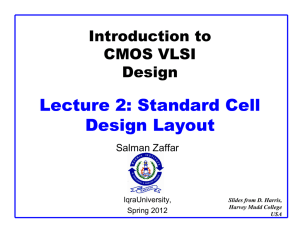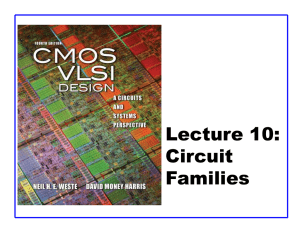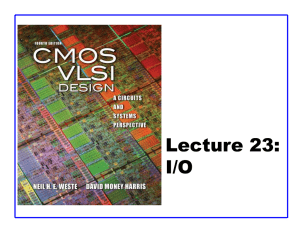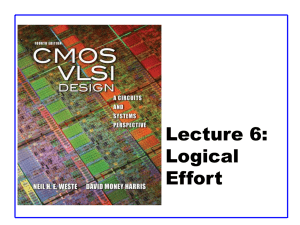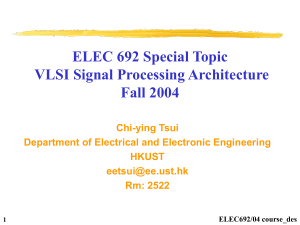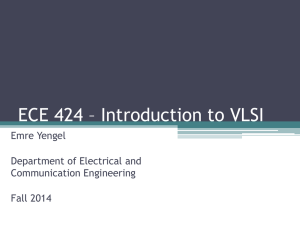CMOS VLSI Design CMOS VLSI Design 4th Ed.
advertisement
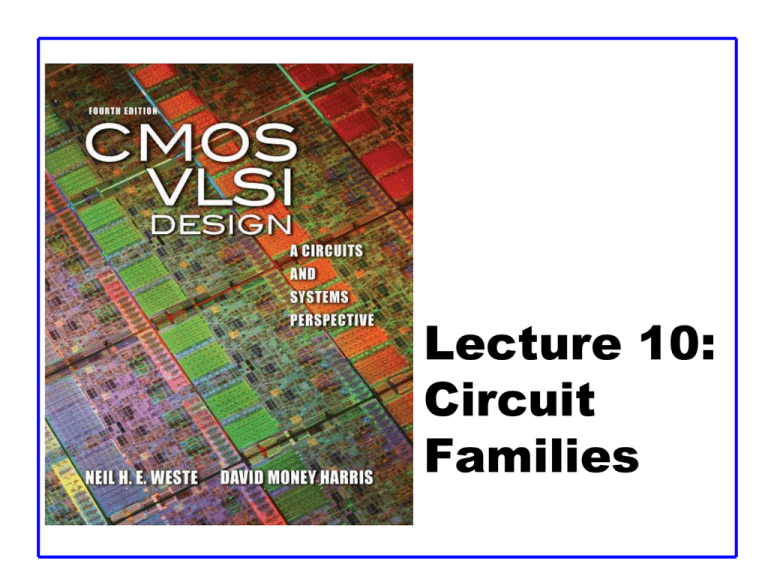
Lecture 10: Circuit Families Outline Pseudo-nMOS Logic (Ratioed Logic) Dynamic Logic Pass Transistor Logic 10: Circuit Families CMOS VLSI Design 4th Ed. 2 Introduction What makes a circuit fast? – I = C dV/dt -> tpd (C/I) DV – low capacitance – high current 4 B – small swing 4 A Logical effort is proportional to C/I 1 1 pMOS are the enemy! – High capacitance for a given current Can we take the pMOS capacitance off the input? Various circuit families try to do this… 10: Circuit Families CMOS VLSI Design 4th Ed. Y 3 Ratioed Logic VDD Resistive Load VDD Depletion Load RL PDN VSS (a) resistive load PMOS Load VSS VT < 0 F In1 In2 In3 VDD F In1 In2 In3 PDN VSS (b) depletion load NMOS F In1 In2 In3 PDN VSS (c) pseudo-NMOS Goal: to reduce the number of devices over complementary CMOS 4 CMOS VLSI Design 4th Ed. Ratioed Logic VDD • N transistors + Load Resistive Load • VOH = V DD RL • VOL = RPN + RL F In1 In2 In3 • Assymetrical response PDN • Static power consumption VSS 5 RPN • tpL= 0.69 RLCL CMOS VLSI Design 4th Ed. Active Loads VDD Depletion Load VDD PMOS Load VT < 0 VSS F In1 In2 In3 PDN F In1 In2 In3 PDN VSS depletion load NMOS 6 VSS pseudo-NMOS CMOS VLSI Design 4th Ed. Pseudo-nMOS In the old days, nMOS processes had no pMOS – Instead, use pull-up transistor that is always ON In CMOS, use a pMOS that is always ON – Ratio issue – Make pMOS about ¼ effective strength of pulldown network 1.8 1.5 load P/2 1.2 P = 24 Ids Vout 0.9 Vout 16/2 Vin 0.6 P = 14 0.3 P=4 0 0 0.3 0.6 0.9 1.2 1.5 1.8 Vin 10: Circuit Families CMOS VLSI Design 4th Ed. 7 Pseudo-nMOS 10: Circuit Families CMOS VLSI Design 4th Ed. 8 Pseudo-NMOS VTC 10: Circuit Families CMOS VLSI Design 4th Ed. 9 Pseudo-nMOS Design Size of PMOS VOL Static Power Dissipation tpLH 4 0.693 V 564 mW 14 ps 2 0.273 V 298 mW 56 ps 1 0.133 V 160 mW 123 ps 0.5 0.064 V 80 mW 268 ps 0.25 0.031 V 41 mW 569 ps 10: Circuit Families CMOS VLSI Design 4th Ed. 10 Pseudo-nMOS Gates Design for unit current on output to compare with unit inverter. pMOS fights nMOS Iout = 4I/3 – I/3 Inverter Y A Y inputs f NAND2 gu gd gavg pu pd pavg = = = = = = 10: Circuit Families A B gu g Y gd avg pu pd pavg NOR2 = = = = = = A CMOS VLSI Design 4th Ed. B gu gd gavg Y pu pd pavg = = = = = = 11 Pseudo-nMOS Gates Design for unit current on output to compare with unit inverter. pMOS fights nMOS Y inputs f Inverter 2/3 Y A 4/3 NAND2 gu gd gavg pu pd pavg = 4/3 = 4/9 = 8/9 = 6/3 = 6/9 = 12/9 10: Circuit Families gu g Y gd avg 8/3 pu pd 8/3 pavg 2/3 A B NOR2 = 8/3 = 8/9 = 16/9 = 10/3 = 10/9 = 20/9 2/3 A CMOS VLSI Design 4th Ed. 4/3 B gu gd gavg Y pu 4/3 pd pavg = 4/3 = 4/9 = 8/9 = 10/3 = 10/9 = 20/9 12 Pseudo-nMOS Design Ex: Design a k-input AND gate using pseudo-nMOS. Estimate the delay driving a fanout of H Pseudo-nMOS G = 1 * 8/9 = 8/9 F = GBH = 8H/9 P = 1 + (4+8k)/9 = (8k+13)/9 N=2 4 2 H 8k 13 1/N D = NF + P = 3 9 10: Circuit Families In1 1 Ink 1 CMOS VLSI Design 4th Ed. Y H 13 Pseudo-nMOS Power Pseudo-nMOS draws power whenever Y = 0 – Called static power P = IDDVDD – A few mA / gate * 1M gates would be a problem – Explains why nMOS went extinct Use pseudo-nMOS sparingly for wide NORs Turn off pMOS when not in use en Y A 10: Circuit Families B C CMOS VLSI Design 4th Ed. 14 Ratio Example The chip contains a 32 word x 48 bit ROM – Uses pseudo-nMOS decoder and bitline pullups – On average, one wordline and 24 bitlines are high Find static power drawn by the ROM – Ion-p = 36 mA, VDD = 1.0 V Solution: Ppull-up VDD I pull-up 36 μW Pstatic (31 24) Ppull-up 1.98 mW 10: Circuit Families CMOS VLSI Design 4th Ed. 15 Pseudo-NMOS Design Pseudo-nMOS gates will not operate correctly if VOL>VIL of the driven gate. This is most likely in the SF corner. Conservative design requires extra weak pMOS. Another choice is to use replica biasing. Idea comes from analog design. Replica biasing allows 1/3 the current ratio rather than the conservative ¼ ratio of earlier. 10: Circuit Families CMOS VLSI Design 4th Ed. 16 Replica Biasing 10: Circuit Families CMOS VLSI Design 4th Ed. 17 Ganged CMOS 10: Circuit Families CMOS VLSI Design 4th Ed. 18 Ganged CMOS A B N1 P1 N2 P2 Y 0 0 OFF ON OFF ON 1 0 1 OFF ON ON OFF ~0 1 0 ON OFF OFF ON ~0 1 1 ON OFF ON OFF 0 10: Circuit Families CMOS VLSI Design 4th Ed. 19 Improved Loads VDD M1 Enable M2 M1 >> M2 F A B C D Adaptive Load 20 CMOS VLSI Design 4th Ed. CL Improved Loads 10: Circuit Families CMOS VLSI Design 4th Ed. 21 Improved Loads (2) Differential Cascode Voltage Switch Logic (DCVSL) 22 CMOS VLSI Design 4th Ed. DCVSL Example Out Out B B A B B A XOR-NXOR gate 23 CMOS VLSI Design 4th Ed. DCVSL Example 24 CMOS VLSI Design 4th Ed. DCVSL Transient Response 10: Circuit Families CMOS VLSI Design 4th Ed. 25 Pass-Transistor Logic Inputs B Switch Out A Out Network B B • N transistors • No static consumption 26 CMOS VLSI Design 4th Ed. Example: AND Gate 10: Circuit Families CMOS VLSI Design 4th Ed. 27 NMOS-Only Logic 10: Circuit Families CMOS VLSI Design 4th Ed. 28 NMOS-Only Switch 29 CMOS VLSI Design 4th Ed. NMOS Only Logic: Level Restoring Transistor • Advantage: Full Swing • Restorer adds capacitance, takes away pull down current at X • Ratio problem 30 CMOS VLSI Design 4th Ed. Restorer Sizing 10: Circuit Families CMOS VLSI Design 4th Ed. 31 LEAP LEAn integration with Pass transistors Get rid of pMOS transistors – Use weak pMOS feedback to pull fully high – Ratio constraint S A S L Y B 10: Circuit Families CMOS VLSI Design 4th Ed. 32 Complementary Pass Transistor Logic A A B B Pass-Transistor Network F (a) A A B B B B B A F B B F=AB A B F=A+B F=AB AND/NAND A F=AÝ (b) A A B B A A B 33 Inverse Pass-Transistor Network F=A+B B OR/NOR A EXOR/NEXOR CMOS VLSI Design 4th Ed. F=AÝ CPL Complementary Pass-transistor Logic – Dual-rail form of pass transistor logic – Avoids need for ratioed feedback – Optional cross-coupling for rail-to-rail swing S A S L Y L Y B S A S B 10: Circuit Families CMOS VLSI Design 4th Ed. 34 Alternative CPL 10: Circuit Families CMOS VLSI Design 4th Ed. 35 Transmission Gate 10: Circuit Families CMOS VLSI Design 4th Ed. 36 Resistance of Transmission Gate 30 2.5 V Resistance, ohms Rn 20 2.5 V Vou t Rp 10 0 0.0 37 Rp Rn 0V Rn || Rp 1.0 Vou t , V 2.0 CMOS VLSI Design 4th Ed. Pass Transistor Circuits Use pass transistors like switches to do logic Inputs drive diffusion terminals as well as gates CMOS + Transmission Gates: – 2-input multiplexer – Gates should be restoring S S A A S S Y Y B B S 10: Circuit Families S CMOS VLSI Design 4th Ed. 38 Pass-Transistor Based Multiplexer S S VDD S A VDD M2 F S M1 B S GND 39 In1 S S In2 CMOS VLSI Design 4th Ed. Transmission Gate XOR 10: Circuit Families CMOS VLSI Design 4th Ed. 40 Delay in Transmission Gate Networks 10: Circuit Families CMOS VLSI Design 4th Ed. 41 Delay Optimization 42 CMOS VLSI Design 4th Ed. Transmission Gate Full Adder P VDD VDD Ci A P A A P B VDD Ci A P Ci S Sum Generation Ci P B VDD A P Co Carry Generation Ci A Setup P Similar delays for sum and carry 43 CMOS VLSI Design 4th Ed. Other Pass Transistor Families DPTL (Differential Pass Transistor Logic) DPL (Double Pass Transistor Logic) EEPL (Energy Economized Pass Transistor Logic) PPL (Push-Pull Pass Transistor Logic) SRPL (Swing Restored Pass Transistor Logic) DCVSPG (Differential Cascode Voltage Switch with Pass Gate Logic) 10: Circuit Families CMOS VLSI Design 4th Ed. 44 Pass Transistor Summary Researchers investigated pass transistor logic for general purpose applications in the 1990’s – Benefits over static CMOS were small or negative – No longer generally used However, pass transistors still have a niche in special circuits such as memories where they offer small size and the threshold drops can be managed 10: Circuit Families CMOS VLSI Design 4th Ed. 45 Single Clock 2-Phase System T/2 10: Circuit Families T 3T/2 CMOS VLSI Design 4th Ed. 46 Shift Register VDD P HIBA R VDD P HI A P HI P HIBA R 10: Circuit Families CMOS VLSI Design 4th Ed. 47 Shift Register When f = 1, data move through the first transmission gate to the inverter. TG RTG CL CL CTG Cinv Cline When VA 1, t Vin t VDD 1 e TG When VA 0, Vin t VDD e 10: Circuit Families t TG CMOS VLSI Design 4th Ed. 48 Charge Leakage P HIBAR A CL P HI 10: Circuit Families CMOS VLSI Design 4th Ed. 49 Charge Leakage IL ILn ILp dVin C IL dt dQstore ILp ILn dt dQstore Cstore dV 10: Circuit Families CMOS VLSI Design 4th Ed. 50 Charge Leakage Both Q and I are nonlinear Assume that I’s are constant. Qstore Cstore V dV Cstore ILp ILn dt ILp ILn V t t V 0 Cstore C DV t max store IL f min 1 IL 2t max 2Cstore DV CMOS VLSI Design 4th Ed. 10: Circuit Families 51 Charge Sharing P HIBA R C1 C2 P HI 10: Circuit Families CMOS VLSI Design 4th Ed. 52 Charge Sharing We can write At t 0, V1 VDD ,V2 0, QT C1VDD At t t f , QT C1 C2 V f C1 Vf VDD C1 C2 The more general case: N QT CiVi 0, i1 N QT Ci V f i1 N C V 0 i i Vf i1 N C i i1 10: Circuit Families CMOS VLSI Design 4th Ed. 53 Dynamic CMOS In static circuits at every point in time (except when switching) the output is connected to either GND or VDD via a low resistance path. – fan-in of n requires 2n (n N-type + n P-type) devices Dynamic circuits rely on the temporary storage of signal values on the capacitance of high impedance nodes. – requires on n + 2 (n+1 N-type + 1 P-type) transistors 54 CMOS VLSI Design 4th Ed. Dynamic Gate Clk Clk Mp off Mp on Out In1 In2 In3 CL A PDN C B Clk Me Clk Two phase operation Precharge (Clk = 0) Evaluate (Clk = 1) 56 1 Out ((AB)+C) CMOS VLSI Design 4th Ed. off Me on Conditions on Output Once the output of a dynamic gate is discharged, it cannot be charged again until the next precharge operation. Inputs to the gate can make at most one transition during evaluation. Output can be in the high impedance state during and after evaluation (PDN off), state is stored on CL 57 CMOS VLSI Design 4th Ed. Properties of Dynamic Gates Logic function is implemented by the PDN only – number of transistors is N + 2 (versus 2N for static complementary CMOS) Full swing outputs (VOL = GND and VOH = VDD) Non-ratioed - sizing of the devices does not affect the logic levels Faster switching speeds – reduced load capacitance due to lower input capacitance (Cin) – reduced load capacitance due to smaller output loading (Cout) – no Isc, so all the current provided by PDN goes into discharging CL 58 CMOS VLSI Design 4th Ed. Properties of Dynamic Gates Overall power dissipation usually higher than static CMOS – no static current path ever exists between VDD and GND (including Psc) – no glitching – higher transition probabilities – extra load on Clk PDN starts to work as soon as the input signals exceed VTn, so VM, VIH and VIL equal to VTn – low noise margin (NML) Needs a precharge/evaluate clock 59 CMOS VLSI Design 4th Ed. Dynamic Logic Dynamic gates uses a clocked pMOS pullup Two modes: precharge and evaluate 2 A f 2/3 Y 1 Y 1 A Static 4/3 Pseudo-nMOS f Precharge Y A 1 Dynamic Evaluate Precharge Y 10: Circuit Families CMOS VLSI Design 4th Ed. 60 The Foot What if pulldown network is ON during precharge? Use series evaluation transistor to prevent fight. precharge transistor f Y f f Y inputs A Y inputs f f foot footed 10: Circuit Families CMOS VLSI Design 4th Ed. unfooted 61 Logical Effort Inverter f unfooted NAND2 1 gd pd footed 2 2 10: Circuit Families 2 B 2 gd pd = 2/3 = 3/3 f 1 1 B Y gd pd = 2/3 = 3/3 A 1 gd pd = 1/3 = 3/3 1 Y 1 Y A A = 1/3 = 2/3 f f 1 Y 1 Y A f NOR2 A 3 B 3 3 f 1 Y gd pd = 3/3 = 4/3 CMOS VLSI Design 4th Ed. A 2 B 2 2 gd pd = 2/3 = 5/3 62 Issues in Dynamic Design 1: Charge Leakage CLK Clk Mp Out CL A Clk Me Evaluate VOut Precharge Leakage sources Dominant component is subthreshold current 63 CMOS VLSI Design 4th Ed. Solution to Charge Leakage Keeper Clk Mp A Mkp CL Out B Clk Me Same approach as level restorer for pass-transistor logic 64 CMOS VLSI Design 4th Ed. Issues in Dynamic Design 2: Charge Sharing Clk Mp Out A CL B=0 Clk 65 Charge stored originally on CL is redistributed (shared) over CL and CA leading to reduced robustness CA Me CB CMOS VLSI Design 4th Ed. Charge Sharing Example Clk A A B B B Cc=15fF C C Ca=15fF Out CL=50fF !B Clk 66 CMOS VLSI Design 4th Ed. Cb=15fF Cd=10fF Charge Sharing VDD case 1) if DV out < VTn VDD Mp Clk f Mp Out Out CL CL Ma A A Ma = BB 00 Clk f 67 M Mb b Mee M XX a CC a CC bb C L VDD = C L Vout t + Ca VDD – V Tn V X or Ca DV out = Vout t – V DD = – -------- V DD – V Tn V X CL case 2) if DV out > VTn C --------------------a - DVout = –V DD C + C a L CMOS VLSI Design 4th Ed. Solution to Charge Redistribution Clk Mp Mkp Clk Out A B Clk Me Precharge internal nodes using a clock-driven transistor (at the cost of increased area and power) 68 CMOS VLSI Design 4th Ed. Issues in Dynamic Design 3: Backgate Coupling Clk Mp A=0 Out1 =1 Out2 =0 CL1 CL2 B=0 Clk Me Dynamic NAND 69 Static NAND CMOS VLSI Design 4th Ed. In Backgate Coupling Effect 3 2 Out1 1 Clk 0 In Out2 -1 0 2 Time, ns 4 CMOS VLSI Design 4th Ed. 6 70 Issues in Dynamic Design 4: Clock Feedthrough Clk Mp A CL B Clk 71 Out Me Coupling between Out and Clk input of the precharge device due to the gate to drain capacitance. So voltage of Out can rise above VDD. The fast rising (and falling edges) of the clock couple to Out. CMOS VLSI Design 4th Ed. Clock Feedthrough Clock feedthrough Clk Out 2.5 In1 In2 1.5 In3 In & Clk 0.5 In4 Clk Out -0.5 0 0.5 Time, ns 1 Clock feedthrough 72 CMOS VLSI Design 4th Ed. Other Effects 73 Capacitive coupling Substrate coupling Minority charge injection Supply noise (ground bounce) CMOS VLSI Design 4th Ed. Cascading Dynamic Gates V Clk Mp Clk Mp Out1 Me Clk Out2 In In Clk Clk Me Out1 VTn DV Out2 t Only 0 1 transitions allowed at inputs! 74 CMOS VLSI Design 4th Ed. Monotonicity Dynamic gates require monotonically rising inputs during evaluation f – 0 -> 0 A – 0 -> 1 – 1 -> 1 violates monotonicity – But not 1 -> 0 during evaluation A f Precharge Evaluate Precharge Y Output should rise but does not 10: Circuit Families CMOS VLSI Design 4th Ed. 75 Monotonicity Woes But dynamic gates produce monotonically falling outputs during evaluation Illegal for one dynamic gate to drive another! A=1 f A Y f Precharge Evaluate Precharge X X X monotonically falls during evaluation Y Y should rise but cannot 10: Circuit Families CMOS VLSI Design 4th Ed. 76 Domino Logic Clk In1 In2 In3 Clk 77 Mp 11 10 PDN Me Out1 Clk Mp Mkp 00 01 In4 In5 Clk PDN Me CMOS VLSI Design 4th Ed. Out2 Domino Gates Follow dynamic stage with inverting static gate – Dynamic / static pair is called domino gate – Produces monotonic outputs f Precharge Evaluate Precharge domino AND W W X Y Z X A B C f Y Z dynamic static NAND inverter f A B 10: Circuit Families f f W X H C CMOS VLSI Design 4th Ed. Y H Z = A B f X Z C 78 Domino Optimizations Each domino gate triggers next one, like a string of dominos toppling over Gates evaluate sequentially but precharge in parallel Thus evaluation is more critical than precharge HI-skewed static stages can perform logic f S0 S1 S2 S3 D0 D1 D2 D3 H Y f 10: Circuit Families S4 S5 S6 S7 D4 D5 D6 D7 CMOS VLSI Design 4th Ed. 79 Dual-Rail Domino Domino only performs noninverting functions: – AND, OR but not NAND, NOR, or XOR Dual-rail domino solves this problem – Takes true and complementary inputs – Produces true and complementary outputs sig_h sig_l Meaning 0 0 Precharged 0 1 ‘0’ 1 0 ‘1’ 1 1 invalid 10: Circuit Families f Y_l inputs f Y_h f f CMOS VLSI Design 4th Ed. 80 Example: AND/NAND Given A_h, A_l, B_h, B_l Compute Y_h = AB, Y_l = AB Pulldown networks are conduction complements f Y_l A_h = A*B A_l B_l Y_h = A*B B_h f 10: Circuit Families CMOS VLSI Design 4th Ed. 81 Example: XOR/XNOR Sometimes possible to share transistors f Y_l = A xnor B A_h Y_h A_l A_l B_l B_h A_h = A xor B f 10: Circuit Families CMOS VLSI Design 4th Ed. 82 np-CMOS 10: Circuit Families CMOS VLSI Design 4th Ed. 83 NORA Logic 10: Circuit Families CMOS VLSI Design 4th Ed. 84 NP Domino 10: Circuit Families CMOS VLSI Design 4th Ed. 85 Zipper CMOS The NP-Domino or NORA logic is very susceptible to noise and leakage. Zipper Domino has the same structure, but the precharge transistors are left slightly ON during evaluation. 10: Circuit Families CMOS VLSI Design 4th Ed. 86 Leakage Dynamic node floats high during evaluation – Transistors are leaky (IOFF 0) – Dynamic value will leak away over time – Formerly miliseconds, now nanoseconds Use keeper to hold dynamic node – Must be weak enough not to fight evaluation weak keeper f A 1 k X H Y 2 2 10: Circuit Families CMOS VLSI Design 4th Ed. 87 Charge Sharing Dynamic gates suffer from charge sharing f f A Y CY x A Y B=0 Cx Charge sharing noise x CY Vx VY VDD Cx CY 10: Circuit Families CMOS VLSI Design 4th Ed. 88 Secondary Precharge Solution: add secondary precharge transistors – Typically need to precharge every other node Big load capacitance CY helps as well f Y A secondary precharge transistor x B 10: Circuit Families CMOS VLSI Design 4th Ed. 89 Noise Sensitivity Dynamic gates are very sensitive to noise – Inputs: VIH Vtn – Outputs: floating output susceptible noise Noise sources – Capacitive crosstalk – Charge sharing – Power supply noise – Feedthrough noise – And more! 10: Circuit Families CMOS VLSI Design 4th Ed. 90 Power Domino gates have high activity factors – Output evaluates and precharges • If output probability = 0.5, a = 0.5 – Output rises and falls on half the cycles – Clocked transistors have a = 1 – For a 4 input NAND, aCMOS = 3/16, aDynamic = 1/4 Leads to very high power consumption However, glitching does not occur in dynamic logic. The load capacitances are lower. 10: Circuit Families CMOS VLSI Design 4th Ed. 91 Completion Detection 10: Circuit Families CMOS VLSI Design 4th Ed. 92 Keepers Keeper design is not trivial. Many alternatives have been suggested. 10: Circuit Families CMOS VLSI Design 4th Ed. 93 Conventional Keeper 10: Circuit Families CMOS VLSI Design 4th Ed. 94 Weak Keepers 10: Circuit Families CMOS VLSI Design 4th Ed. 95 Differential Keeper 10: Circuit Families CMOS VLSI Design 4th Ed. 96 Burn-in Conditional Keeper 10: Circuit Families CMOS VLSI Design 4th Ed. 97 Adaptive Keeper 10: Circuit Families CMOS VLSI Design 4th Ed. 98 Leakage Current Replica Keeper 10: Circuit Families CMOS VLSI Design 4th Ed. 99 Footed and Footless Domino 10: Circuit Families CMOS VLSI Design 4th Ed. 100 8-input Domino AND 10: Circuit Families CMOS VLSI Design 4th Ed. 101 8-input Domino AND 10: Circuit Families CMOS VLSI Design 4th Ed. 102 MODL It is often necessary to compute multiple functions where one is a subfunction of the other or shares a subfunction. One very typical example is the carry in addition: c1 g1 p1c 0 c 2 g2 p2 g1 p1c 0 c 3 g3 p3 g2 p2 g1 p1c 0 c 4 g4 p4 g3 p3 g2 p2 g1 p1c 0 10: Circuit Families CMOS VLSI Design 4th Ed. 103 MODL Carry Chains 10: Circuit Families CMOS VLSI Design 4th Ed. 104 MODL Beware of sneak paths. Certain inputs must be mutually exclusive. 10: Circuit Families CMOS VLSI Design 4th Ed. 105 Domino Summary Domino logic is attractive for high-speed circuits – 1.3 – 2x faster than static CMOS – But many challenges: • Monotonicity, leakage, charge sharing, noise Widely used in high-performance microprocessors in 1990s when speed was king Largely displaced by static CMOS now that power is the limiter Still used in memories for area efficiency 10: Circuit Families CMOS VLSI Design 4th Ed. 106 2-input MUX 10: Circuit Families CMOS VLSI Design 4th Ed. 107 Which Logic Style? Ease of design Robustness Area Speed Power 10: Circuit Families CMOS VLSI Design 4th Ed. 108 Which Logic Style? Ease of Design Robustness Area Speed Power Static Very good Very good Bad Bad Good PseudonMOS Average Average Good Good Very bad Pass transistor Difficult Average Good (for specific circuits) Good (for specific circuits) average Dynamic logic Very difficult Very bad Good Good average 10: Circuit Families CMOS VLSI Design 4th Ed. 109 Circuit Pitfalls Threshold drops Ratio failures Charge sharing Power supply noise Coupling Minority carrier injection Back-gate coupling Diffusion input noise sensitivity Race conditions Delay matching 10: Circuit Families CMOS VLSI Design 4th Ed. 110 Circuit Pitfalls Metastability Hot spots Soft errors Process sensitivity 10: Circuit Families CMOS VLSI Design 4th Ed. 111 Threshold Drops 10: Circuit Families CMOS VLSI Design 4th Ed. 112 Ratio Failures 10: Circuit Families CMOS VLSI Design 4th Ed. 113 Power Supply Noise 10: Circuit Families CMOS VLSI Design 4th Ed. 114 Hot Spots Caused by nonuniform power dissipation even when the overall power consumption is within budget. Causes variation in delay between gates. Full-chip temperature simulation is required. 10: Circuit Families CMOS VLSI Design 4th Ed. 115 Minority Carrier Injection 10: Circuit Families CMOS VLSI Design 4th Ed. 116 Minority Carrier Injection Sometimes, a node voltage can momentarily exceed power supply voltages. Then, the drain-body junction becomes forward biased. Noise tools can identify potential problems. 10: Circuit Families CMOS VLSI Design 4th Ed. 117 Diffusion Input Noise Sensitivity 10: Circuit Families CMOS VLSI Design 4th Ed. 118 Diffusion Input Noise Sensitivity Exposed diffusion inputs are particularly sensitive to noise. Standard cell latches should be built with buffered inputs. In data paths, one can still utilize exposed diffusion inputs since one knows the structure. 10: Circuit Families CMOS VLSI Design 4th Ed. 119 Domino Noise Budgets Charge leakage Charge sharing Capacitive coupling Back-gate coupling Minority carrier injection Power supply noise Soft errors Noise feedthrough Process corner effects 10: Circuit Families CMOS VLSI Design 4th Ed. 120 Domino Noise Budgets Source Dynamic Output Dynamic Input Charge Sharing 10 n/a Coupling 17 7 Supply Noise 5 5 Feedthrough Noise 5 7 Total 37% 19% 10: Circuit Families CMOS VLSI Design 4th Ed. 121 Silicon-on-Insulator Circuit Design SOI technology has been around for decades as research. It was adopted by IBM for PowerPC in 1998. Potential for higher performance and lower power consumption. Higher manufacturing cost and more complicated circuit design due to unusual transistor behavior. There is no bulk, but insulator. Body is floating, thus changes in Vt. 10: Circuit Families CMOS VLSI Design 4th Ed. 122 SOI Inverter Cross Section 10: Circuit Families CMOS VLSI Design 4th Ed. 123 SOI Process Electron Micrograph 10: Circuit Families CMOS VLSI Design 4th Ed. 124 SOI Circuit Design SOI devices are characterized as – Partially Depleted (PD) – Fully Depleted (FD) In FD SOI, the body is thinner than the channel depletion width, so the body charge is fixed. Thus, the body voltage does not change. In PD SOI, the body is thicker and its voltage can vary depending on how much charge is present. This varying body voltage changes Vt. FD SOI is difficult to manufacture. 10: Circuit Families CMOS VLSI Design 4th Ed. 125 Charge Paths in SOI Body 10: Circuit Families CMOS VLSI Design 4th Ed. 126 Charge Paths There are two paths through which charge can build up in the body: – Reverse biased drain-to-body (Ddb) and possibly source-tobody (Dsb) junctions. – High-energy carriers causing impact ionization, creating electron-hole pairs. Some electrons are injected into the gate or gate oxide, leaving holes behind. The charge can exit the body through two paths: – As body voltage increases, Dsb becomes slightly forward biased. Eventually, this cancels the first mechanism above. – A rising gate or drain voltage capacitively couples the body voltage upward, too. This strongly forward biases Dsb junction and charge spills out. 10: Circuit Families CMOS VLSI Design 4th Ed. 127 SOI Advantages Lower diffusion capacitance. – Smaller parasitic delay and lower power consumption. Potential for lower threshold voltages. – Vt is dependent on channel length for bulk CMOS. Thus, worst case conditions are selected in determining Vt. In SOI, variations are smaller, thus smaller Vt can be chosen. Lower n, hence better subthreshold slope. – n decreases from 1.5 to about 1.2. SOI is immune to latchup. 10: Circuit Families CMOS VLSI Design 4th Ed. 128 SOI Disadvantages PD SOI suffers from history effect. – 8% variation in gate delay. – Can be a problem for sensitive analog circuits. Presence of a parasitic bipolar transistor. – If the source and drain are held high for an extended period of time while the gate is low, the base will float high due to leakage. – If the source is pulled low, the npn turns ON, creating a pulse of current. – This is sometimes called pass-gate leakage. Self-heating => oxide is an insulator for heat as well. 10: Circuit Families CMOS VLSI Design 4th Ed. 129 Parasitic BJT in SOI 10: Circuit Families CMOS VLSI Design 4th Ed. 130 Implications for Circuit Styles SOI is attractive for fast CMOS logic. – Lower delay, lower power consumption. Standard CMOS design suffers slightly from history effect. Dynamic circuits suffer from pass-gate leakage. Many precautions must be taken. Analog circuits suffer from threshold mismatches. 10: Circuit Families CMOS VLSI Design 4th Ed. 131 Subthreshold Circuit Design As discussed earlier, the minimum energy point is at a region where VDD < Vt. Typically, around 300 mV. Frequency is in the high kHz or low MHz region. Vt variations are very important, use large transistors where possible. Use standard CMOS, but avoid complex gates. Not more complex than NAND3. Due to variations, ON current in one branch may be smaller than OFF current in the series stack. 10: Circuit Families CMOS VLSI Design 4th Ed. 132 Pitfalls and Fallacies Failing to plan for advances in technology Comparing a well-tuned new circuit to a poor example of engineering practice Ignoring driver resistance when characterizing passtransistor circuits. Reporting only part of the delay of a circuit Making outrageous claims about performance Building circuits without adequate verification tools. Sizing subthreshold circuits for speed 10: Circuit Families CMOS VLSI Design 4th Ed. 133 Historical Perspective Ratioed and dynamic circuits are actually earlier than CMOS. In an NMOS process, PMOS transistors were not available. Dynamic gates were proposed in early 1970’s. Even with CMOS, domino gates were still used for area and power advantages, for example in BELLMAC-32A from Bell Labs. – The world’s first 32-bit microprocessor 10: Circuit Families CMOS VLSI Design 4th Ed. 134 Historical Perspective By the time of Alpha 21264, leakage had become so important that keepers had to be used. – 1996, superscalar, out-of-order execution 180 nm Pentium 4 used self-resetting domino. 90 nm Pentium 4 used extraordinarily complex LVS logic. Custom design of 6.8M transistors. Japanese engineers favored pass transistor logic all through 1990’s. IBM has always relied on static CMOS. Hundreds of logic families in academic literature, but very few have found application in industry. 10: Circuit Families CMOS VLSI Design 4th Ed. 135
